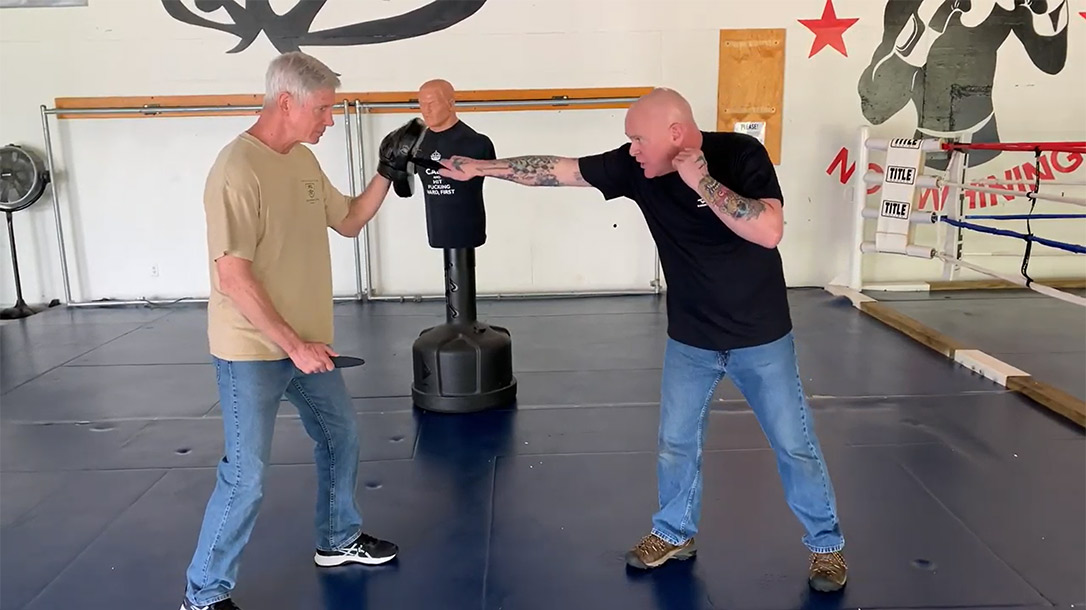Let’s be honest, most people will likely never find themselves in a knife defense situation. However, with that said, it is not unheard of. It actually happens more often than you would think. Do a quick YouTube search for knife attacks and see how many come up. So, even though it is not likely, it is possible. With that said, the key to cut prevention is to get in and out quickly. This is where snap cuts and thrusts come in handy.
Using Snap Cuts and Thrusts in a Knife Defense Scenario
To be clear, this is regarding defensive knife use. Although these techniques can be used offensively, they are geared more towards defensive application. This article is also not to be considered legal advice. Every scenario is different, and the legality of your defensive knife use is between your lawyer and the District Attorney. As with any self-defense scenario, avoidance is ideal.
Advertisement — Continue Reading Below
First thing’s first, if you are dealing with a knife-wielding attacker and can safely get out of there, do. Getting cut by a knife can range from fairly insignificant to lethal. So, it is just best not to present the chance. However, if you cannot get out of there, then quick in and out defensive measures are your next best option.
Although there are good knife fighting systems out there, they take a lot of time to perfect. For this reason, it is good to know some quick and simple defensive measures that present the least risk. With their snake-like approach to quickly entering and exiting, the snap cut and thrust present the least amount of time for the attacker to target your arm.
Snap cuts and snap thrusts are designed to protect your space and keep the attacker from coming in. The techniques are very similar to the boxing jab and are natural movements. The only difference is that you have a knife in your hand.
Advertisement — Continue Reading Below
Snap Thrusts
The snap thrust is very much like a jab in boxing. You are not hooking downward, you are simply shooting the knife straight out and straight back, point first. Much like a punch, you want to turn your hand, so it is palm down. This will give you more strength in your structure and protect your vital arteries on the inside of your wrist.
When you withdraw the blade, you want to twist the blade by turning your hand, so it is palm up as you pull out. As a result, you will create what Michael Janich of Martial Blade Concepts calls a C cut. By doing so, it opens the wound channel even more than the blade simply going straight in and coming straight back out. Thus, causing more damage that may slow the attacker down quicker.
Snap thrusts are intended to target large areas, like center mass, neck, etc. Although you could target the arms, they will be a much smaller target and will be moving quickly. Legs would be easier to target than arms but present a similar problem.
Advertisement — Continue Reading Below
Snap Cuts
Much like snap thrusts, snap cuts are in and out quickly. However, unlike snap thrusts, which are intended to penetrate, snap cuts are intended to cut. For this reason, snap cuts are ideal for arms and legs that are coming in. You can also use snaps cuts on the body, but they are more specific to targeting incoming attacks.
Snap cuts should not be confused with slashes, they are completely different. Slashes are larger movements with the intention of maximum penetration. For example, slashes move more like a cross punch in boxing whereas snap cuts snap out and back in like a jab.
A snap cut is performed in a saber grip and is like cracking a whip, forcing the tip deep into the subject matter. When performing a snap cut, you hyperextend the elbow while pushing the tip forward with the thumb. Again, the motion is much like the way a whip would move or even a snake striking. Although snap cuts work fine with a drop point blade, the Wharncliffe style of blade is perfect for this type of cut.
Advertisement — Continue Reading Below
Snap cuts and thrusts are fast and effective when dealing with incoming attacks, in defense of your space. When you add footwork to the equation, you gain the angle and increase the odds of effectiveness. The key is to move in and out quickly so you are not feeding your attacker anything they can cut.
Keep it real and stay safe.























